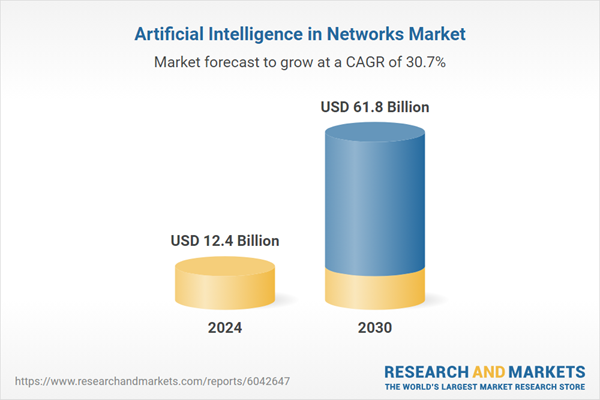The global market for Artificial Intelligence in Networks was valued at US$12.4 Billion in 2024 and is projected to reach US$61.8 Billion by 2030, growing at a CAGR of 30.7% from 2024 to 2030. This comprehensive report provides an in-depth analysis of market trends, drivers, and forecasts, helping you make informed business decisions.
AI systems monitor vast amounts of network data in real time, detecting anomalies and predicting potential failures before they impact performance. This proactive approach reduces downtime and ensures uninterrupted service delivery. Additionally, AI enhances network security by identifying suspicious activities, such as unauthorized access or unusual traffic patterns, allowing organizations to respond to threats swiftly.
In addition to operational efficiency, AI is optimizing bandwidth allocation and traffic management. By analyzing usage patterns, AI systems dynamically adjust network resources to meet demand, improving performance and user experience. These advancements are making AI indispensable in managing the growing complexity of modern network infrastructures.
The growing emphasis on network security is another critical factor. Cybersecurity threats are evolving rapidly, and traditional security measures often struggle to keep up. AI-powered systems enhance threat detection and response by analyzing network behavior in real time and identifying anomalies that could indicate potential breaches. This capability is particularly valuable for organizations dealing with sensitive data and critical infrastructure.
Moreover, the demand for automation and cost efficiency is driving the adoption of AI in networks. Automated network management reduces operational costs by minimizing manual interventions and streamlining processes. AI also improves resource utilization, enabling organizations to achieve higher efficiency and lower total cost of ownership (TCO) for their network infrastructure.
In terms of scalability, AI enables networks to adapt dynamically to changing demands. For instance, in 5G networks, AI optimizes resource allocation and manages traffic congestion, ensuring consistent performance even during peak usage. These capabilities are essential for supporting the exponential growth of connected devices and applications, particularly in sectors such as telecommunications, healthcare, and manufacturing.
AI also supports self-healing networks, where automated systems detect and resolve issues without human intervention. This reduces the burden on IT teams and ensures faster resolution of problems. These advancements are transforming the way organizations manage their networks, making them more reliable, scalable, and efficient.
Consumer expectations for seamless and reliable connectivity are also driving investments in AI-driven network management. Enterprises and service providers are adopting AI solutions to deliver superior user experiences and maintain competitive advantages.
Additionally, advancements in AI technologies, such as deep learning and natural language processing, are enhancing the capabilities of network management systems. These innovations enable more accurate predictions, faster anomaly detection, and smarter resource allocation. Regulatory initiatives promoting cybersecurity and the need for robust data protection are further supporting the adoption of AI in networks. These factors, combined with increasing investments in digital transformation, are fueling the rapid growth of the AI in Networks market, positioning it as a cornerstone of future connectivity and infrastructure management.
Global Artificial Intelligence in Networks Market - Key Trends & Drivers Summarized
How is AI Transforming Network Management?
Artificial Intelligence (AI) is revolutionizing network management by introducing intelligent automation, predictive analytics, and real-time optimization. Traditional networks often require manual configuration and monitoring, which can lead to inefficiencies and delays in identifying and resolving issues. AI-powered solutions address these challenges by automating network operations and providing actionable insights through machine learning (ML) and advanced data analytics.AI systems monitor vast amounts of network data in real time, detecting anomalies and predicting potential failures before they impact performance. This proactive approach reduces downtime and ensures uninterrupted service delivery. Additionally, AI enhances network security by identifying suspicious activities, such as unauthorized access or unusual traffic patterns, allowing organizations to respond to threats swiftly.
In addition to operational efficiency, AI is optimizing bandwidth allocation and traffic management. By analyzing usage patterns, AI systems dynamically adjust network resources to meet demand, improving performance and user experience. These advancements are making AI indispensable in managing the growing complexity of modern network infrastructures.
What Drives the Adoption of AI in Networks?
The increasing complexity of network environments is a significant driver of AI adoption in this sector. With the rise of 5G, IoT devices, and cloud computing, networks are becoming more dynamic and data-intensive. AI solutions provide the intelligence and scalability needed to manage these complexities effectively, ensuring seamless connectivity and performance.The growing emphasis on network security is another critical factor. Cybersecurity threats are evolving rapidly, and traditional security measures often struggle to keep up. AI-powered systems enhance threat detection and response by analyzing network behavior in real time and identifying anomalies that could indicate potential breaches. This capability is particularly valuable for organizations dealing with sensitive data and critical infrastructure.
Moreover, the demand for automation and cost efficiency is driving the adoption of AI in networks. Automated network management reduces operational costs by minimizing manual interventions and streamlining processes. AI also improves resource utilization, enabling organizations to achieve higher efficiency and lower total cost of ownership (TCO) for their network infrastructure.
Can AI Improve Network Reliability and Scalability?
AI is playing a crucial role in enhancing network reliability and scalability, two critical factors for modern organizations. By analyzing historical and real-time data, AI systems predict and prevent network outages, ensuring uninterrupted service delivery. Predictive maintenance capabilities identify potential hardware or software issues before they escalate, reducing downtime and enhancing reliability.In terms of scalability, AI enables networks to adapt dynamically to changing demands. For instance, in 5G networks, AI optimizes resource allocation and manages traffic congestion, ensuring consistent performance even during peak usage. These capabilities are essential for supporting the exponential growth of connected devices and applications, particularly in sectors such as telecommunications, healthcare, and manufacturing.
AI also supports self-healing networks, where automated systems detect and resolve issues without human intervention. This reduces the burden on IT teams and ensures faster resolution of problems. These advancements are transforming the way organizations manage their networks, making them more reliable, scalable, and efficient.
What's Driving the Growth of the AI in Networks Market?
The growth in the Artificial Intelligence in Networks market is driven by several key factors, reflecting its increasing importance in modern infrastructure management. The rapid expansion of 5G networks and IoT ecosystems is creating a surge in demand for intelligent network solutions that can handle high volumes of data and dynamic connectivity requirements. AI-powered tools provide the agility and intelligence needed to meet these demands.Consumer expectations for seamless and reliable connectivity are also driving investments in AI-driven network management. Enterprises and service providers are adopting AI solutions to deliver superior user experiences and maintain competitive advantages.
Additionally, advancements in AI technologies, such as deep learning and natural language processing, are enhancing the capabilities of network management systems. These innovations enable more accurate predictions, faster anomaly detection, and smarter resource allocation. Regulatory initiatives promoting cybersecurity and the need for robust data protection are further supporting the adoption of AI in networks. These factors, combined with increasing investments in digital transformation, are fueling the rapid growth of the AI in Networks market, positioning it as a cornerstone of future connectivity and infrastructure management.
Report Scope
The report analyzes the Artificial Intelligence in Networks market, presented in terms of market value (USD). The analysis covers the key segments and geographic regions outlined below.Segments
Component (Software Component, Hardware Component, Services Component); Deployment (Cloud-based Deployment, On-Premise Deployment); Technology (Machine Learning Technology, Natural Language Processing Technology, Computer Vision Technology, Deep Learning Technology, Other Technologies); End-Use (Telecommunications End-Use, IT End-Use, Data Centers End-Use, Healthcare End-Use, Energy & Utilities End-Use, Other End-Uses).Geographic Regions/Countries
World; United States; Canada; Japan; China; Europe (France; Germany; Italy; United Kingdom; and Rest of Europe); Asia-Pacific; Rest of World.Key Insights:
- Market Growth: Understand the significant growth trajectory of the AI Software segment, which is expected to reach US$28.8 Billion by 2030 with a CAGR of a 31.3%. The AI Hardware segment is also set to grow at 26.6% CAGR over the analysis period.
- Regional Analysis: Gain insights into the U.S. market, valued at $3.3 Billion in 2024, and China, forecasted to grow at an impressive 29.1% CAGR to reach $9.3 Billion by 2030. Discover growth trends in other key regions, including Japan, Canada, Germany, and the Asia-Pacific.
Why You Should Buy This Report:
- Detailed Market Analysis: Access a thorough analysis of the Global Artificial Intelligence in Networks Market, covering all major geographic regions and market segments.
- Competitive Insights: Get an overview of the competitive landscape, including the market presence of major players across different geographies.
- Future Trends and Drivers: Understand the key trends and drivers shaping the future of the Global Artificial Intelligence in Networks Market.
- Actionable Insights: Benefit from actionable insights that can help you identify new revenue opportunities and make strategic business decisions.
Key Questions Answered:
- How is the Global Artificial Intelligence in Networks Market expected to evolve by 2030?
- What are the main drivers and restraints affecting the market?
- Which market segments will grow the most over the forecast period?
- How will market shares for different regions and segments change by 2030?
- Who are the leading players in the market, and what are their prospects?
Report Features:
- Comprehensive Market Data: Independent analysis of annual sales and market forecasts in US$ Million from 2024 to 2030.
- In-Depth Regional Analysis: Detailed insights into key markets, including the U.S., China, Japan, Canada, Europe, Asia-Pacific, Latin America, Middle East, and Africa.
- Company Profiles: Coverage of players such as Arista Networks, Inc., Broadcom, Inc., Cisco Systems, Inc., Extreme Networks, Inc., Huawei Technologies Co., Ltd. and more.
- Complimentary Updates: Receive free report updates for one year to keep you informed of the latest market developments.
Some of the 34 companies featured in this Artificial Intelligence in Networks market report include:
- Arista Networks, Inc.
- Broadcom, Inc.
- Cisco Systems, Inc.
- Extreme Networks, Inc.
- Huawei Technologies Co., Ltd.
- IBM Corporation
- Juniper Networks, Inc.
- Nokia Corporation
- Telefonaktiebolaget LM Ericsson
- ZTE Corporation
Table of Contents
I. METHODOLOGYII. EXECUTIVE SUMMARY2. FOCUS ON SELECT PLAYERSIII. MARKET ANALYSISCANADAITALYREST OF EUROPEREST OF WORLDIV. COMPETITION
1. MARKET OVERVIEW
3. MARKET TRENDS & DRIVERS
4. GLOBAL MARKET PERSPECTIVE
UNITED STATES
JAPAN
CHINA
EUROPE
FRANCE
GERMANY
UNITED KINGDOM
ASIA-PACIFIC
Table Information
| Report Attribute | Details |
|---|---|
| No. of Pages | 206 |
| Published | February 2025 |
| Forecast Period | 2024 - 2030 |
| Estimated Market Value ( USD | $ 12.4 Billion |
| Forecasted Market Value ( USD | $ 61.8 Billion |
| Compound Annual Growth Rate | 30.7% |
| Regions Covered | Global |









